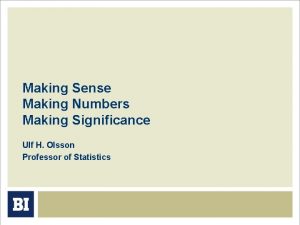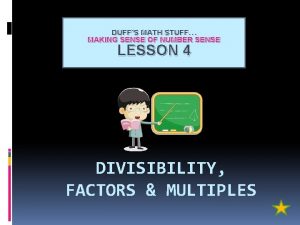Making Sense of the Social World 4 th








- Slides: 8

Making Sense of the Social World 4 th Edition Chapter 4: Conceptualization and Measurement

Levels of Measurement The mathematical precision with which the values of a variable can be expressed is the level of measurement. • The nominal level of measurement, which is qualitative, has no mathematical interpretation; • The quantitative levels of measurement—ordinal, interval, and ratio—are progressively more precise mathematically. Chambliss/Schutt, Making Sense of the Social World 4 th edition © 2012 SAGE Publications

Nominal Measures The nominal level of measurement identifies variables whose values have no mathematical interpretation; they vary in kind or quality but not in amount. In terms of the variable “Dog Breed, ” you can say that the German Shepherd is not equal to the Terrier, but you cannot say that the “German Shepherd” is “dog breedier” or “less dog breedy ” than the Terrier. Chambliss/Schutt, Making Sense of the Social World 4 th edition © 2012 SAGE Publications

Ordinal Measures At this level, you specify only the order of the cases, in “greater than” and “less than” distinctions. At the coffee shop, for example, you might choose between a small, medium, or large cup of decaf —that’s ordinal measurement. Chambliss/Schutt, Making Sense of the Social World 4 th edition © 2012 SAGE Publications

Interval Measures At the interval level of measurement, numbers represent fixed measurement units but have no absolute zero point. Your text uses the example of temperatures measured with the Fahrenheit scale. The temperature can definitely go below zero, as indicated in this weather forecast for Fargo, ND. Chambliss/Schutt, Making Sense of the Social World 4 th edition © 2012 SAGE Publications

Another good example is seen in an index of feminist attitudes. Two women were asked a series of questions that, when their answers were compiled, an index of their feminist attitudes could be calculated, but the index had no absolute zero. Still, their scores could be compared. Do you agree or disagree with the following statements? (SD =1, D=2, N=3, A=4, SA=5) 1. A woman should have the same job opportunities as a man. 2. Men should respect women more than they currently do. 3. America should pass the Equal Rights Amendment. 4. Women should be considered as seriously as men as candidates for the Presidency of the United States. 5. Doctors need to take women's health concerns more seriously. 6. Women have been treated unfairly on the basis of their gender throughout most of human history. (Adapted from Morgan, Betsy Levonian. 1996. "Putting the Feminism Into Feminism Scales: Introduction of a Liberal Feminist Attitude and Ideology Scale (LFAIS). ” Sex Roles 34 (5– 6) 359– 390. Feminist Attitude index = 30 (highest score possible) Feminist Attitude index = 5 (lowest score Chambliss/Schutt, Making Sense of the Social World 4 th edition © 2012 SAGE Publications

Ratio Measures A ratio level of measurement represents fixed measuring units with an absolute zero point. Zero, in this situation, means absolutely no amount of whatever the variable indicates. On a ratio scale, 10 is two points higher than 8 and is also two times greater than 5. Ratio numbers can be added and subtracted, and because the numbers begin at an absolute zero point, they can also be multiplied and divided (so ratios can be formed between the numbers). Chambliss/Schutt, Making Sense of the Social World 4 th edition © 2012 SAGE Publications

Types of Comparisons That Can Be Made With Different Levels of Measurement Examples of Appropriate Relevant level of measurement comparison statements math operations A is equal to (not equal to) B = (≠) A is greater than (less than) B > (<) A is three more than (less than) B + (–) A is twice (half) as large as B ´ (/) Chambliss/Schutt, Making Sense of the Social World 4 th edition © 2012 SAGE Publications Nominal Ordinal Interval Ratio √ √ √ √ √
 Narrow sense heritability vs broad sense heritability
Narrow sense heritability vs broad sense heritability Narrow sense heritability vs broad sense heritability
Narrow sense heritability vs broad sense heritability Making sense of discourse
Making sense of discourse What is inferring
What is inferring War making and state making as organized crime summary
War making and state making as organized crime summary Social thinking and social influence in psychology
Social thinking and social influence in psychology Social thinking social influence social relations
Social thinking social influence social relations Social psychology and common sense
Social psychology and common sense Hình ảnh bộ gõ cơ thể búng tay
Hình ảnh bộ gõ cơ thể búng tay















